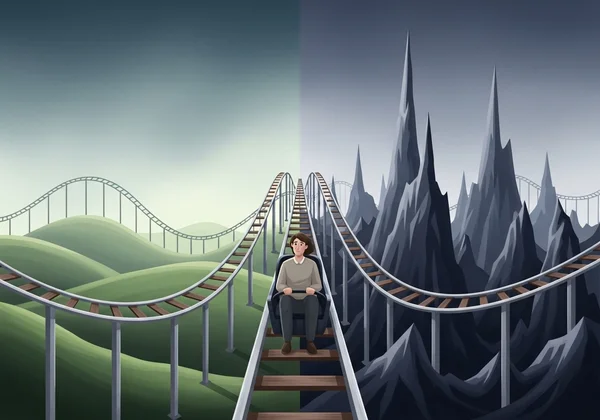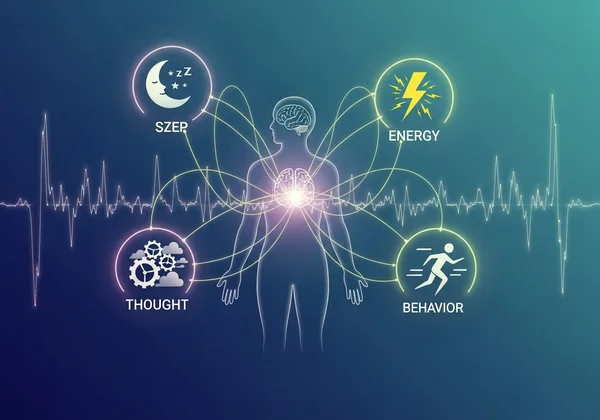Am I Bipolar or Just Moody? Take Our Free Bipolar Test
Feeling caught on an emotional rollercoaster, wondering if your intense highs and lows are just a part of your personality or something more? You're not alone. Many people experience significant emotional fluctuations, making it incredibly difficult to tell the difference between typical moodiness and a potential mental health condition like bipolar disorder. If you’ve ever asked yourself, Am I bipolar or just moody?, this guide is for you. We'll explore the seven crucial distinctions that separate everyday mood swings from the clinical symptoms of bipolar disorder, empowering you to better understand your experiences and decide on your next steps. For an initial insight, a confidential bipolar test can be a helpful starting point.

Duration & Severity: Are Your Moods Fleeting or Persistent?
One of the most significant differentiators is the sheer length and intensity of the mood episodes. Everyday moods are typically temporary and manageable, whereas bipolar episodes are sustained and powerful.
Understanding Normal Mood Swings
For most people, normal mood swings are brief and reactive. You might feel elated after receiving good news or irritable after a stressful day at work. These feelings are usually tied to specific events, last for a few hours or a day, and rarely stop you from fulfilling your responsibilities. While uncomfortable, you can generally manage these feelings and continue with your daily life.
The Clinical Criteria for Bipolar Episodes
In contrast, the mood shifts in bipolar disorder are distinct, prolonged episodes of either depression or mania/hypomania. According to clinical guidelines like the DSM-5, a major depressive episode must last at least two consecutive weeks. A manic episode must last at least one week (or less if hospitalization is required), while a hypomanic episode must last for at least four consecutive days. These aren't just bad days; they are sustained periods of a significantly altered mood state that is a noticeable change from your usual self.
Impact on Daily Life: When Moods Disrupt Function
How your moods affect your ability to function is a critical clue. While being moody can make a day more challenging, the episodes associated with bipolar disorder often cause significant disruption to a person's life.
Functional Impairment in Bipolar Disorder
A hallmark of bipolar disorder is functional impairment. During a depressive episode, a person may lack the energy to get out of bed, go to work, or engage in basic self-care. During a manic episode, impulsivity and poor judgment can lead to severe consequences in relationships, finances, and career. These mood states aren't just internal feelings; they actively interfere with and damage key areas of a person's life.
When Normal Moods Don't Get in the Way
While a bad mood can certainly make you less productive or social, it typically doesn't derail your entire life. You might feel down, but you still manage to complete your projects, pay your bills, and maintain your relationships. The resilience to push through and the quick recovery from emotional shifts are key features that distinguish everyday moodiness from a clinical condition.

The Presence of Mania or Hypomania: More Than Just Feeling "Up"
This is perhaps the most defining difference. Bipolar disorder is characterized by distinct periods of abnormally elevated or irritable mood, known as mania or hypomania. This goes far beyond simply feeling happy or energetic.
Identifying Mania and Hypomania Symptoms
Mania and hypomania symptoms include a decreased need for sleep, being more talkative than usual, having racing thoughts, and feeling a grandiose sense of self-importance. A person in a manic or hypomanic state might engage in impulsive, high-risk behaviors like spending sprees, reckless driving, or unsafe sexual encounters. Hypomania is a less severe form, but it's still a noticeable and sustained shift from a person's normal state. If these descriptions resonate, considering an online bipolar screening could offer clarity.
Energy Shifts vs. Hypomanic Episodes
It's normal to have high-energy days where you feel productive and cheerful. The key difference is the nature of that energy. A normal "up" mood is typically manageable and positive. A hypomanic episode, however, often feels out of control. Your thoughts may be too fast to keep up with, and your energy can feel wired and agitated, often leading to irritability rather than pure joy.
Pattern & Triggers: Is There a Logic to Your Lows and Highs?
Observing the patterns and triggers behind your mood shifts can provide valuable insight. Normal moods are often logical reactions to life, while bipolar episodes can seem to appear out of nowhere.
Recognizing Bipolar Cycles
While stress can certainly trigger a bipolar episode, it's not always the case. Bipolar cycles can occur independently of external events, sometimes following a seasonal or cyclical pattern. A person might experience a severe depressive episode despite everything in their life going well. This apparent lack of a direct cause is a strong indicator that something more than situational moodiness is at play.
Situational Mood Swings
Most normal mood swings are situational. You feel sad because of a disappointment, happy because of an achievement, or angry because of an injustice. There's a clear and understandable link between the external event and your internal emotional response. Once the situation is resolved or time passes, the mood typically lifts.
Co-occurring Symptoms: Beyond Just Moods Themselves
Bipolar disorder affects more than just your emotions. It's a systemic condition that involves changes in your physical state, thought processes, and behaviors.
Physical, Cognitive, and Behavioral Symptoms
During bipolar episodes, you may experience significant changes in sleep patterns (sleeping very little during mania, or excessively during depression), appetite, and energy levels. Cognitively, you might struggle with "racing thoughts" during mania or severe concentration problems during depression. Behaviorally, speech can become rapid and pressured, or slow and hesitant. These widespread changes are not characteristic of simple moodiness.
Simpler Emotional Responses
Typical moodiness is primarily an emotional experience. You might feel sad or happy, but it usually doesn't come with a complete overhaul of your sleep schedule, thought speed, and physical energy levels. The experience is less pervasive and doesn't impact your entire system in the same way.

Biological Basis: Genetics, Brain Chemistry, and Environment
Understanding the underlying causes also helps draw a clear line between moodiness and bipolar disorder. Bipolar disorder is a recognized medical condition with strong biological roots.
The Role of Neurobiology in Bipolar Disorder
Research shows that bipolar disorder is linked to genetics, brain structure, and neurochemistry. It often runs in families and is considered a brain-based disorder. This biological underpinning is why it requires clinical treatment and management, not just a change in attitude or lifestyle.
Everyday Stressors and Hormonal Influences
Everyday moodiness, on the other hand, is often influenced by common life stressors, hormonal fluctuations, lack of sleep, or diet. These factors can certainly make you feel moody, but they don't cause the distinct and severe episodes seen in bipolar disorder.
Need for Professional Help: When to Seek an Assessment
Finally, the most crucial difference is the need for professional intervention. While everyone can learn coping skills for managing moods, bipolar disorder requires a professional diagnosis and a comprehensive treatment plan.
Why Self-Assessment Isn't a Diagnosis
Reading articles like this and exploring your experiences is a fantastic and empowering first step. However, a self-assessment is not a diagnosis. Only a qualified mental health professional, like a psychiatrist or psychologist, can perform a thorough evaluation to determine if you meet the criteria for bipolar disorder.
Taking the Next Step Towards Clarity
If the patterns described in this article feel deeply familiar, it’s a sign that seeking more information is a wise choice. A great place to start is with a confidential and science-based screening tool. Our free bipolar test is based on the Mood Disorder Questionnaire (MDQ) and can provide you with immediate insights into your mood patterns. This can be a valuable piece of information to bring to a conversation with a doctor or therapist.

Distinguishing between normal moodiness and bipolar disorder is the first critical step toward self-understanding and finding the right support. Normal moods are typically brief, reactive, and don't stop you from living your life. Bipolar disorder involves prolonged, severe episodes of depression and mania/hypomania that significantly disrupt your ability to function and have a biological basis.
If this article has raised more questions than answers, that’s okay. Your journey to clarity starts with curiosity. We encourage you to take the first step on our homepage to gain private, instant insights. Remember, this is a screening tool, not a diagnosis, but it can empower you to have a more informed conversation with a mental health professional who can guide you toward a healthier, more stable future.
Disclaimer: This content is for informational purposes only and does not constitute medical advice. The screening tool on this website is not a diagnostic test. Please consult a qualified healthcare professional for any health concerns or before making any decisions related to your health or treatment.
Frequently Asked Questions About Moods and Bipolar Disorder
How can I tell the difference between normal moodiness and bipolar disorder?
The key differences lie in duration, severity, and impact on your daily life. Bipolar episodes last for days or weeks, are severe enough to disrupt work and relationships, and often include the distinct highs of mania or hypomania, which are not part of typical mood swings.
What are some common signs that might indicate bipolar disorder?
Common signs include distinct periods of depression (low energy, sadness, loss of interest) alternating with periods of mania or hypomania (high energy, reduced need for sleep, racing thoughts, impulsive behavior). If you notice these cyclical patterns, it's a good reason to explore further. You can get a preliminary idea by using a bipolar symptoms test.
How accurate are online tests for bipolar disorder?
Online screening tools, like the one offered on our site, are designed to be a reliable first step. They are based on standardized questionnaires used in clinical settings (like the MDQ) to help identify individuals who may be at risk and should seek a professional evaluation. They are highly useful for screening but cannot provide a diagnosis.
What should I do if I suspect I have bipolar disorder?
If you suspect you may have bipolar disorder, the recommended path is twofold. First, you can use a confidential online screening tool to organize your thoughts and see if your experiences align with common patterns. Second, and most importantly, schedule an appointment with a mental health professional, such as a psychiatrist or therapist, to discuss your concerns and get a comprehensive evaluation.